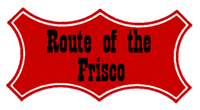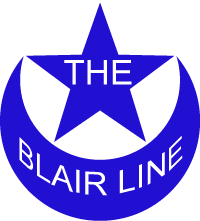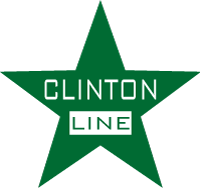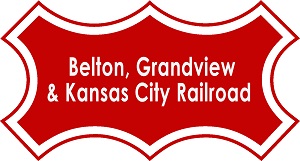The line on which the Belton, Grandview & Kansas City Railroad runs has a long history, stretching back over 100 years to the late 1800's when railroads were branching out in all directions. There were actually 2 railroads that ran through Belton back at the turn of the last century. The Kansas City, Clinton & Springfield (KCCS) affectionately known as the "Leaky Roof" and the Kansas City, Osceola & Southern (KCO&S) also known as "The Blair Line". The Belton Grandview & Kansas City runs on a short remnant of the KCO&S. The only part of the KCCS that still exists in Belton is the track to the southwest of our main line, closest to the fire station. That track was once the main line of the KCCS, but that short section is all that remains.
The Kansas City, Clinton & Springfield Railroad Co. was begun in 1884 as a direct route from Kansas City to Springfield via Henry County. It incorporated the Atchison Topeka & Santa Fe Railroad's Peasant Hill & De Soto branch after a deal was stuck between the AT&SF and the Kansas City Fort Scott & Gulf Railroad, which was the company behind the KCCS. The Fort Scott ran south from Kansas City to Arcadia near Pittsburgh KS before turning east to Springfield, the KCCS was intended to be a more direct route and would meet up with the Fort Scott main line in Ash Grove.
The KCCS line ran east from Olathe, KS, through Belton, then over through Raymore. From there it went south to Harrisonville, on to Clinton, Lowry City, Osceola and Humansville. To reach Kansas City KCCS trains would use the Fort Scott line from Olathe into Kansas City where it came into the Kansas City Union Depot in the West Bottoms. The village of Urich relocated several miles south of its former location so that it could be on the new rail line when it was completed in 1885.
The nick name "Leaky Roof" came from the old and somewhat run down freight cars the KCCS used. One of their major customers was the W. S. Dicky Clay Company in Deepwater. The company shipped clay tiles on KCCS which were impervious to the elements, and because of this, just about any old freight car would do. According to legend the superintendent of the White Swan Flour Mill in Clinton, which shipped flower over the KCCS, looked out over their yards and told his men not to ship any flour that day because of all the leaky roofs.
In 1891 the Kansas City, Osceola & Southern was begun when the defunct Kansas City & Southern Railway which was formed in 1880 and not to be confused with today's KCS, was reorganized as the KCO&S. The KC&S had built lines from North Osceola through Clinton, on to East Lynne and then up to Knoche Junction in Kansas City which the Kansas City, Osceola & Southern then took over. In 1897 the KCO&S signed an agreement with the St. Louis & San Francisco Railroad, commonly known as the "Frisco", which called for the KCO&S to build its line further on, constructing a bridge across the Osage River and extending its line into Osceola and on to Bolivar.
 In 1901 the St. Louis - San Francisco Railroad, merged the Fort Scott into their operations, giving them control of the Kansas City, Clinton & Springfield. At about the same time, however, the Frisco exercised its right granted in the 1897 traffic agreement to purchase the Kansas City Osceola & Southern, and the KCO&S became the the Frisco Kansas City Branch. This merger gave the Frisco control of 3 major rail routes between Kansas City and Springfield and this did not sit well with many people including Missouri state regulators. To fend off possible problems, the Frisco put the KCCS stock in trust and continued to operate, at least on paper, the KCCS as an independent railroad, now officially nicknamed the Clinton Line. Though supposedly independent passenger tickets on the KCCS could transfer to the KCO&S, and like wise.
In 1901 the St. Louis - San Francisco Railroad, merged the Fort Scott into their operations, giving them control of the Kansas City, Clinton & Springfield. At about the same time, however, the Frisco exercised its right granted in the 1897 traffic agreement to purchase the Kansas City Osceola & Southern, and the KCO&S became the the Frisco Kansas City Branch. This merger gave the Frisco control of 3 major rail routes between Kansas City and Springfield and this did not sit well with many people including Missouri state regulators. To fend off possible problems, the Frisco put the KCCS stock in trust and continued to operate, at least on paper, the KCCS as an independent railroad, now officially nicknamed the Clinton Line. Though supposedly independent passenger tickets on the KCCS could transfer to the KCO&S, and like wise.
 The KCO&S was known as the Blair Line, named for John Blair, a New Jersey investor who was behind forming the KCO&S. When the Frisco took over the KCO&S, they referred to it as the "High Line" because of it's route through the Osage Mountains. The line started out at the old Grand Central Station at 2nd and Wyandotte (mile post 0), ran to the Knoche Junction (mp 3.8) then down through Swope Park (mp 14.0), Holmes Road (mp 18.1) Grandview (mp 22.7), Belton (mp 28.2), Peculiar (mp 36.7), then to Harrisonville (mp 45.2), East Lynne (mp 51.8), and Gunn City (mp 56.1). Mile Posts 29 (Belton Park) and 30 can be seen while riding the BG&KC RR today and they still refer to the old starting point in Kansas City.
The KCO&S was known as the Blair Line, named for John Blair, a New Jersey investor who was behind forming the KCO&S. When the Frisco took over the KCO&S, they referred to it as the "High Line" because of it's route through the Osage Mountains. The line started out at the old Grand Central Station at 2nd and Wyandotte (mile post 0), ran to the Knoche Junction (mp 3.8) then down through Swope Park (mp 14.0), Holmes Road (mp 18.1) Grandview (mp 22.7), Belton (mp 28.2), Peculiar (mp 36.7), then to Harrisonville (mp 45.2), East Lynne (mp 51.8), and Gunn City (mp 56.1). Mile Posts 29 (Belton Park) and 30 can be seen while riding the BG&KC RR today and they still refer to the old starting point in Kansas City.
 In late 1924 for various legal and financial reason the Frisco took full control of the KCCS and made it the Osceola Subdivision. Once it took control the Frisco began combining KCCS track with the track of the High Line, the former KCO&S which ran parallel to the KCCS for almost the entire route. In 1928 the KCCS track running northwest out of Belton to Stanley KS was abandoned, partly due to the difficult West Belton Hill which had a 3% grade. Trains from Kansas City now all used the Blair line as far as Belton.
In late 1924 for various legal and financial reason the Frisco took full control of the KCCS and made it the Osceola Subdivision. Once it took control the Frisco began combining KCCS track with the track of the High Line, the former KCO&S which ran parallel to the KCCS for almost the entire route. In 1928 the KCCS track running northwest out of Belton to Stanley KS was abandoned, partly due to the difficult West Belton Hill which had a 3% grade. Trains from Kansas City now all used the Blair line as far as Belton.
By 1932 passenger service on the Leaky Roof had all but come to an end, with only 3 mixed trains a week running over that line. Even the High Line was only being serviced by a gas-electric motor car rather than a full train by this time. In 1934 the Frisco applied to the Interstate Commerce Commission to abandon much of the former KCCS. Ironically the Leaky Roof had one last burst of activity. In mid 1934 just after the line was officially abandoned the Missouri State Highway Department ordered a large number of carloads of stone and gravel for the widening of what is now 7 Highway. The Frisco even had to put extra crews on to handle the traffic. But by mid 1935, although there was a great deal of controversy, the Leaky Roof was no more. The tracks from Clinton to Belton were removed, and only small sections of the KCCS remained as part of the Blair Line and as industrial trackage in Harrisonville and other locations.
The High Line continued to operate through the middle part of the 20th century. The last passenger service was in 1954 when regular service ended, however caboose passenger service lasted until the end of all passenger trains on the Frisco in 1967. In 1979 the death knell of the Blair Line was sounded with the completion of Truman Dam. There was not enough revenue to justify building bridges over the soon to be flooded areas, and so the line was abandoned south from East Lynne.
In 1980 the Frisco was acquired by the Burlington Northern Railroad which continued to operate the Blair Line as the Grandview Branch until 1986 when it was sold off by the BN.
Today the Belton Grandview & Kansas City Railroad operates our excursions between the Belton Depot at mile post 28.2 and the end of our line at Cambridge Road alongside US 71. The remainder of the track between there and East Lynne was abandoned and sold due to the extremely high costs of maintaining the railroad track which had seen little maintenance in the years before the BN gave it up. BG&KC also owns the track north from Belton to the north side of 155th street. Although this track is not open for passenger operations. From 155th street the track now belongs to the Kansas City Southern which services a few industries on the spur off its main line through Grandview.
Information for this article was found though the excellent resources of the Henry County Library and the Truman Area Community Network (please note as of June 2018, this link is broken - this information for now is available from the Internet Archive - TACnet Archive), and Marty T. Myers.
More information about the St. Louis - San Francisco Railroad can be found at the Springfield-Greene County Library in their online exhibit"A look back at the Saint Louis-San Francisco Railway" and at the online forums of Frisco.Org
